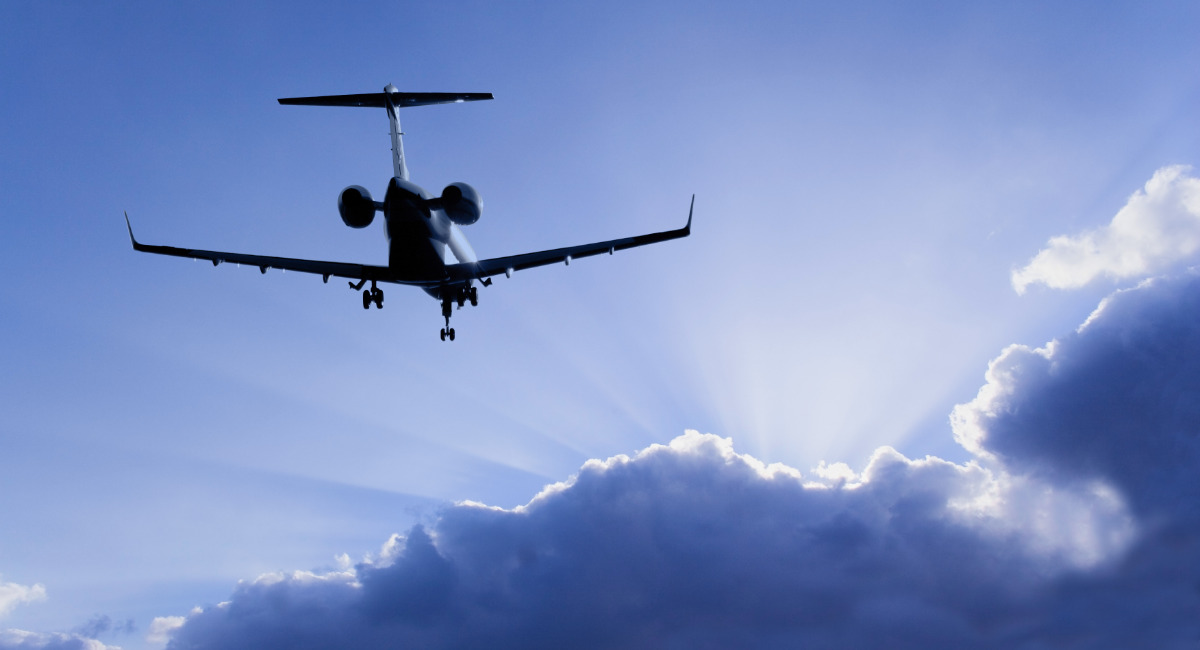Since the Supreme Court’s decision in Dobbs v. Jackson Women’s Health Organization overturned Roe v. Wade, states have been allowed to pass their own abortion laws. As certain states began to pass stronger protections for preborn human beings, other states began to eliminate protections — and ‘abortion travel’ became a hot-button issue.
Some companies began funding abortion travel as a “benefit” to employees, and abortion funds began to pay for airfare, hotels, and the like in order to assist women living in pro-life states to obtain abortions in states where abortion was more available. Since that time, the Guttmacher Institute (a former “special affiliate” of Planned Parenthood) has noted that abortion travel has increased. However, recent reports also allege that abortion funding for travel expenses and abortions may be starting to taper off.
Tragically, as Live Action News previously documented, it is much more difficult to reach women with pro-life alternatives to abortion once they travel outside their home states for abortions.
More than 170,000 Abortion Clients Traveled Out-of-State in 2023
According to the latest data published by the Guttmacher Institute in May of 2024, “… over 170,000 patients traveled out of state in 2023 to seek abortion care.” The precise abortion travel figure was “171,300 people…” according to USA Today.
The number represents nearly 17% of total abortions (1,037,000) reported in 2023 and is an increase from abortion travel numbers just a few years prior.
“Out-of-state travel for abortion care has more than doubled since 2019 when 73,100 patients traveled across state lines for abortions, according to the Guttmacher Institute’s Monthly Abortion Provision Study project,” a report from USA Today read.
This shouldn’t be surprising given the fact that Dobbs changed the landscape of state abortion laws drastically.
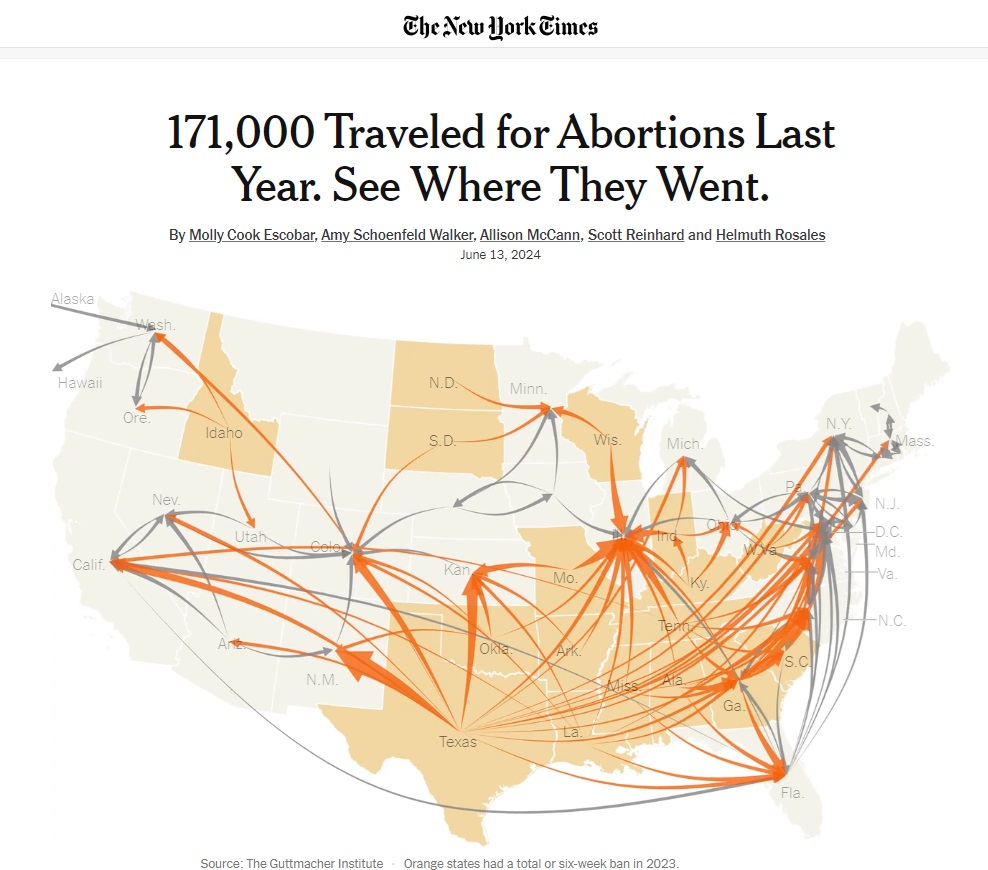
Abortion Travel in 2023 New York Times using Guttmacher Data
Abortion Travel Beyond Border States
According to Guttmacher, there are 14 states that have “near total abortion bans”: Alabama, Arkansas, Idaho, Indiana, Kentucky, Louisiana, Mississippi, Missouri, North Dakota, Oklahoma, South Dakota, Tennessee, Texas, and West Virginia.
“Historically, however, many of the people traveling from restrictive states went to states that now have total abortion bans,” wrote Guttmacher in June of 2024. For instance, in 2020, more than 800 Louisiana residents traveled to Texas for abortion care; following the overturning of Roe v. Wade in 2022, that was no longer possible. In 2023, more than 3,500 Louisianans traveled across multiple states to get care in places like Florida, Illinois and Georgia.”
In 2023, Texas, the largest state to protect nearly all preborn children, “had the most residents travel across state lines for the procedure, the data shows,” claimed the New York Times.
The downloadable abortion travel data showed that Texas residents traveled to multiple states for abortions in 2023, including 14,200 to New Mexico; 4,000 to Colorado; 6,720 to Kansas; 1,150 to Florida; and 3,580 to California, among others.
“Of the 10,570 abortions Tennessee residents obtained in other states last year, 7,120 traveled to Illinois, 1,280 to North Carolina and 880 to Virginia,” The Tennessee Lookout claimed. “Tennessee residents also obtained abortions in California (220), Georgia (950), and South Carolina (120).”
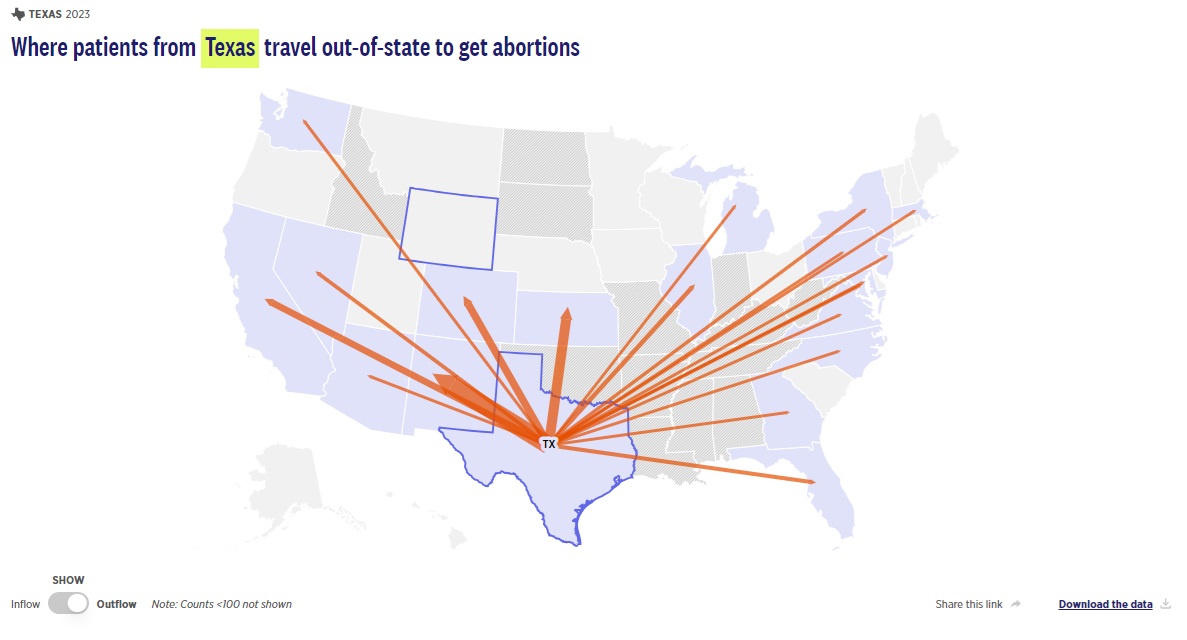
Abortion travel from Texas to multiple other states, 2023 (Graph: Guttmacher Institute)
In 2023, “States bordering ban states had particularly large increases [in abortion travel],” Guttmacher wrote in May.
“In total, abortions in these states increased by 38% between 2020 and 2023, with particularly sharp increases in Illinois (37,700 more abortions than in 2020, or an increase of 71%), New Mexico (15,070 more abortions, an increase of 256%), Virginia (14,420, an increase of 77%) and North Carolina (13,890, or 44%). Much of the increase in these states was due to increased travel across state lines. Illinois, for example, provided abortion care to an estimated 26,000 more patients from out of state, accounting for 69% of its overall increase,” the pro-abortion group added.
Guttmacher clarified that “[n]ot all increases at the state level can be attributed to increased travel across state lines, however. Even states not bordering ban states saw large increases—in total, abortion numbers increased in these states by 18%§ from 2020 to 2023. It is very possible that, while access was dramatically curtailed for people living in ban states, access substantially improved for residents of states without bans.”
Large Increases in Out-of-State Abortions
In a news release, Planned Parenthood of Illinois claimed that since Dobbs, PPIL has seen a “47% increase” in abortion travel with “an unprecedented number of out-of-state patients traveling from 41 different states making up nearly a quarter (25%) of PPIL’s overall abortion patients (before Dobbs it was 3-5%).”
According to Tribune News Service (MSN), “The Illinois Department of Public Health in April awarded a $2 million grant to Planned Parenthood of Illinois and two other organizations — the Chicago-based Midwest Access Project and the University of Illinois Chicago College of Nursing — to increase abortion training statewide, citing the steep rise in need following the Dobbs decision.”
The media outlet cited Gov. J.B. Pritzker as describing the state as “an oasis for women seeking reproductive care,” and pointed out how new facilities are opening in the state, writing, “Equity Clinic is among a slew of new clinics that have opened in Illinois following the overturning of Roe. It was founded in February 2023 by Dr. Keith Reisinger-Kindle,” where “abortion training” is a “cornerstone” to help “foster the next generation of abortion providers.”
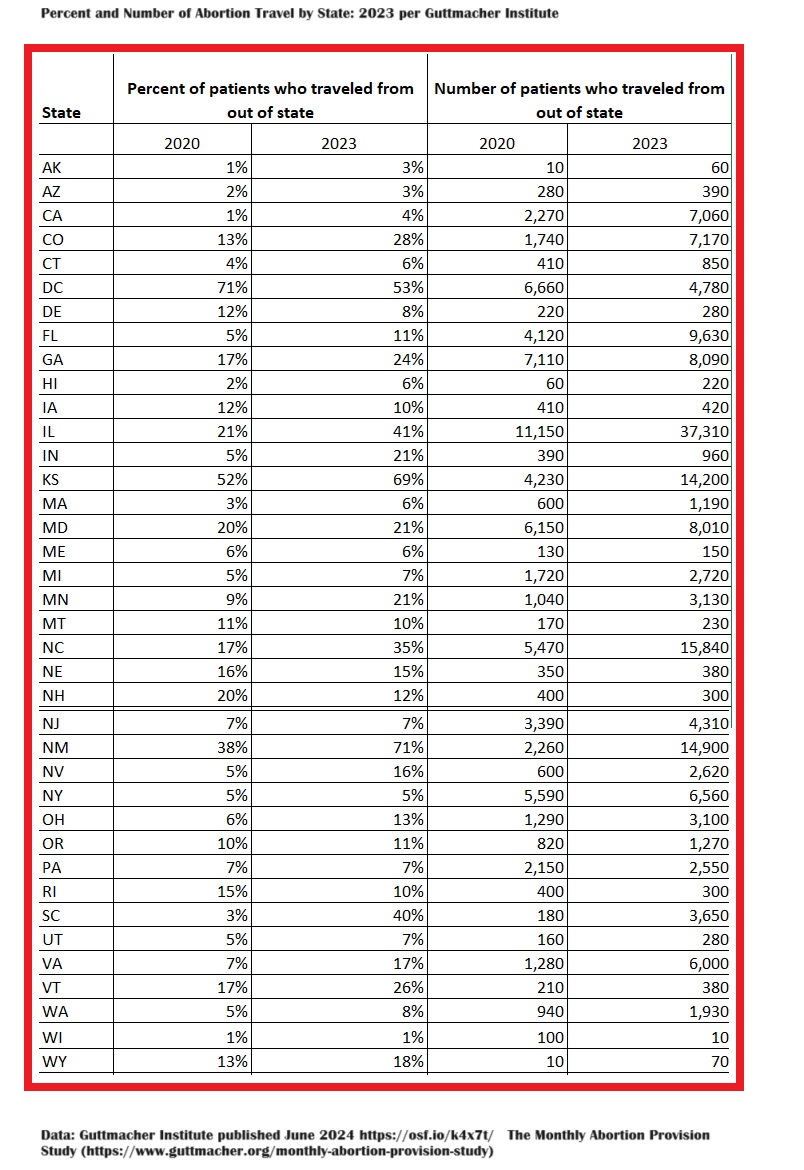
2023 Abortion Travel Number and Percent by State (Spreadsheet: Guttmacher Institute)
“Nearly 70% of the estimated 21,000 clinician-provided abortions in New Mexico last year involved patients who traveled from neighboring Texas [14,200], according to data released this month,” reported the Santa Fe New Mexican, adding that “out-of-state abortions in New Mexico increased from 38% in 2020 to 71% in 2023.”
The Philadelphia Inquirer reported, “Abortions in Pennsylvania among out-of-state residents rose nearly 41% in 2022, driven largely by patients from Ohio and 20 other states that restricted access after the Supreme Court’s decision, according to the latest available data from the Pennsylvania Department of Health.”
In West Virginia, wvpublic.org reported, “At least 2,240 West Virginia residents traveled out of state to receive an abortion in 2023, primarily to neighboring states with less strict abortion laws. Among them, 820 residents traveled to Maryland, 600 traveled to Pennsylvania, 590 traveled to Virginia and 230 traveled to Ohio, according to the Guttmacher Institute…This coincides with a growing percentage of abortions provided to out-of-state residents in Maryland, Ohio and Virginia.”
A recent study claimed, “Following the Dobbs decision, 14.3% of abortions in Oregon were to out-of-state residents compared to 9.6% prior to the Dobbs decision. Out-of-state individuals had a significantly higher odds of having abortions in the second or third trimester and having a procedural abortion compared to their in-state counterparts.”
And, according to NPR, “The latest data show that from January to December 2023, 14,180 abortions, or 69% of Kansas abortions, were performed on out-of-state residents.”
Abortion Travel and Trafficking
Big Abortion and its supporters are committed to financially assisting women to kill their preborn babies with violent abortion rather than helping women to carry to term. In essence, abortion industry representatives are morphing into abortion travel agents to enrich their own pockets.
As such, a number of funding and assistance organizations have formed, and cities (here, here) and states are offering abortion funding as well. In addition, multiple companies have announced their intentions to pay for abortion travel, and the Biden Administration has all but declared abortion travel a constitutional right.
Organizations like Elevated Access vow to fly women across the country for abortions, mobile abortion vans are lurking in border states to kill preborn children, and in Texas, the First Unitarian Church of Dallas is involved in a program that flies low-income women from Texas to New Mexico for abortion.
Other means include:
- Placing abortion vans in border states (here, here, here, here).
- Arranging free flights for women who seek abortions out-of-state (here, here here).
- Creating abortion ships (here, here).
- Abortion tourism (here, here, here, here, here).
- Abortion trafficking by luring teens out of state (here, here).
- City and state abortion havens (here, here).
- Billboards ads (here, here, here, here)
- State and federal abortion websites (CA, NV, NY, HHS, PA).
- Colleges funding abortion travel (here).
- Former abortion facilities remaking themselves as abortion “referral” clinics.
- States becoming abortion havens (here).
- Companies offering financial abortion assistance (here, here, here, here, here).
- And the ongoing flouting of Food and Drug Administration (FDA) safety regulations on the abortion pill, including underground networks that illegally import the drugs across the border (here, here, here, here).
NEW
Five colleges say they would pay for students’ abortion travel.
➡️ College of Wooster
➡️ Kenyon College
➡️ Oberlin College
➡️ University of Idaho
➡️ Vanderbilt UniversityLatest in a series of policies being put into place to expand abortion…
— Live Action News (@LiveActionNews) August 31, 2022
State Medicaid Dollars for Out-of-State Abortions
A White House brief recently described an abortion travel workaround, allowing states to fund abortion with Medicaid dollars even for women who travel from another state.
“HHS issued a letter to U.S. governors inviting them to apply for Section 1115 waivers to expand access to care under the Medicaid program for women traveling from a state where reproductive rights are under attack and women may be denied medical care,” the brief read in part.
”While many states restrict or are seeking to restrict abortion care, we know that many others are interested in expanding access to this essential health care. States do not need to seek federal approval to design approaches to expand access to health care that are funded solely with state dollars. However, to the extent that states are interested in developing approaches that use federal funding, including Medicaid funding under section 1115 demonstration authority, we welcome the opportunity to work with these states,” the letter added. “This is a priority for HHS, and states interested in federal Medicaid funding to expand access to care within the scope of Medicaid’s legal authority for women traveling from a state that has restricted or prohibited abortion are encouraged to engage with the Centers for Medicare & Medicaid Services.”
Abortion Funding ‘State of Emergency’
While abortion travel has been on the increase, the funds raised to help women kill their preborn babies is allegedly dwindling.
“Several leaders of abortion funds around the country convened a call with reporters this month to relay a stark warning ahead of the two-year anniversary of the Dobbs v. Jackson Women’s Health Supreme Court decision that repealed federal abortion protections,” reported the Huffington Post.
The media outlet described the state of abortion funding as being in a “state of emergency.”
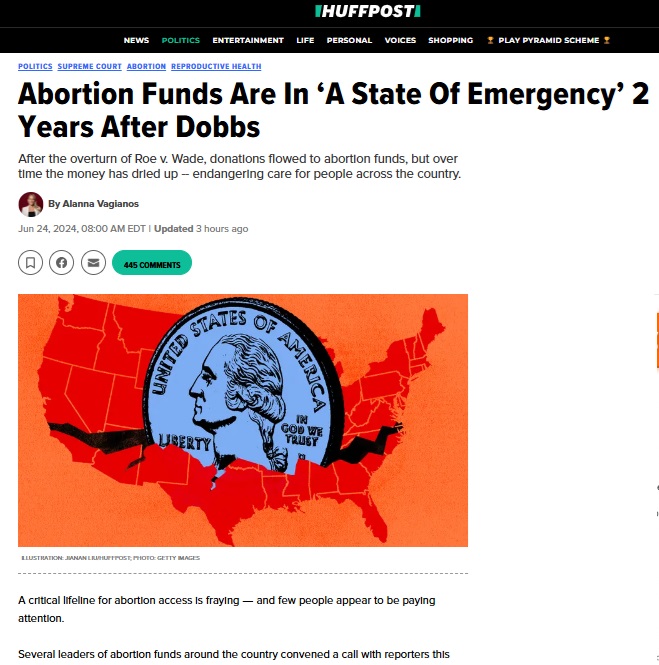
Abortion Funds in State of Emergency Huffington Post
In 2023, funds in the National Network of Abortion Funds (NNAF) provided $36 million for abortions and over $10 million in travel and logistical support, the Huffington Post claimed.
However, Oriaku Njoku, executive director of the NNAF, stated on the call that the groups were now in “crisis.”
“I’m generally not someone to catastrophize the situation, but the reality is that we’ve come together today in crisis,” Njoku said on the call.
“Abortion funds initially saw a historic increase in donations after the fall of Roe v. Wade in June 2022. But since then, donations have dwindled, forcing funds to face the grim reality that they may have to cut staff or close their doors entirely,” HuffPo reported.
In addition to other private funding groups, the media outlet noted, “The National Abortion Federation, along with Planned Parenthood’s national Justice Fund, recently announced that starting July 1, the organizations will only be able to subsidize 30% of costs for abortion seekers ― a decrease from the current cap of 50%. This means that if someone seeking an abortion needs $2,000 to cover the cost of travel, lodging and the procedure itself, funds can only cover up to 30%, or $600, versus 50%, or $1,000.”
At the same time, the abortion corporation is planning to spend $40 million to support abortion in the upcoming elections. In addition, Planned Parenthood is part of a $100 million “investment” with additional organizations to “to secure the federal right to abortion,” the Abortion Access Now Campaign website stated.
Unlike for-profit abortion facilities who promote abortion travel to line their pockets, pro-life pregnancy help centers offer free help to pregnant women.

